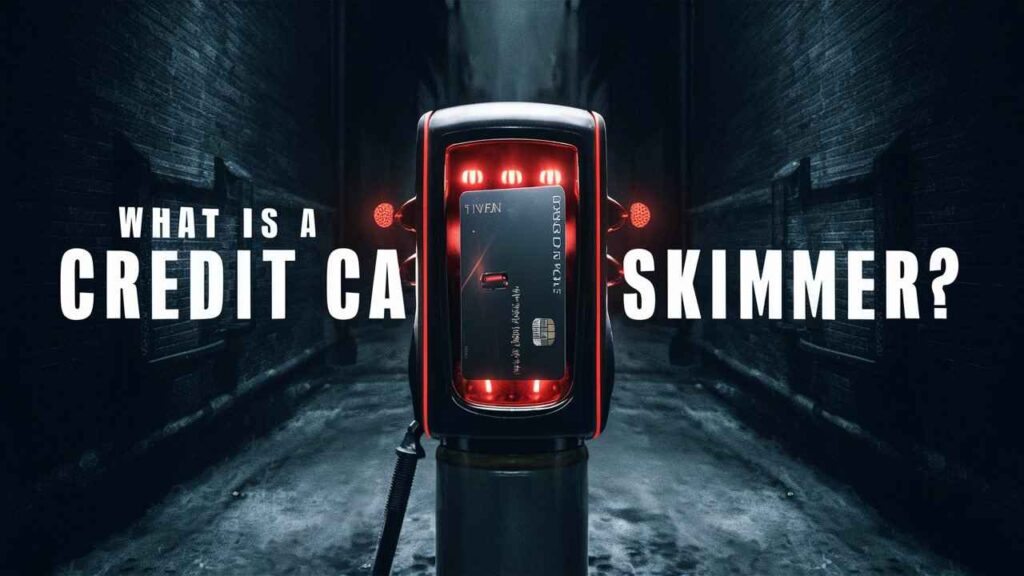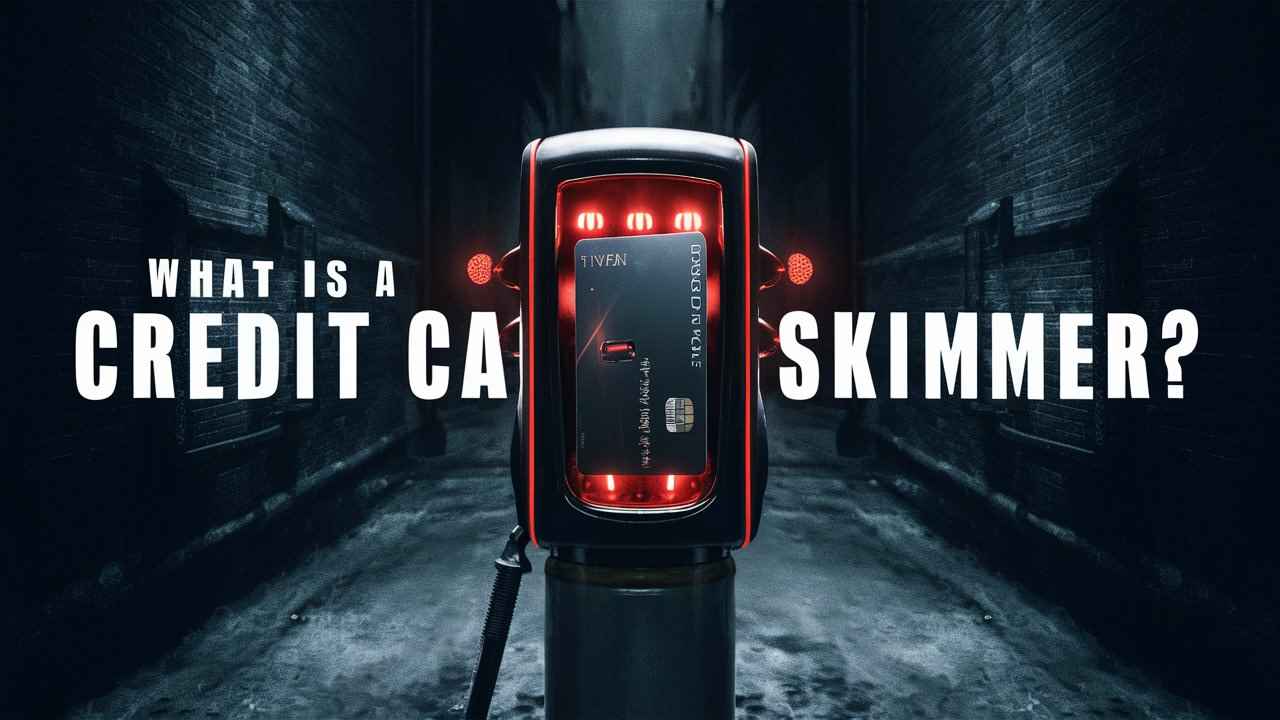Meet Your Wallet’s Worst Nightmare
Imagine this: You’re cruising down the highway, music blasting, and your stomach is rumbling like a hungry bear. You pull into a gas station, fill up, and grab a snack. But what if, unbeknownst to you, a sinister little device was lurking at the pump? Enter the Credit Card Skimmer, the nefarious tool that’s become a real thorn in the side of unsuspecting consumers. As technology advances, so do the crafty methods of thieves, and these little gadgets are quickly becoming the new pet peeve for shoppers everywhere.

Why Credit Card Skimmers Are the New Pet Peeve for Shoppers
Picture this: you go about your day, blissfully swiping your Credit Card for your morning coffee or that extra slice of pizza. Then, you check your account and realize💳wait a minute! Someone in a different zip code has been living it up with your money. That’s right, Credit Card Skimmers have transformed ordinary transactions into a horror movie plot, turning your shopping spree into a financial nightmare. It’s time to shed some light on these mischievous devices and ensure you’re equipped to spot them before they pounce.
What Exactly Is a Credit Card Skimmer?
At its core, a Credit Card Skimmer is a sly little device that captures the information from your Credit Card’s magnetic strip without your knowledge. Think of it as a digital pickpocket💳discreet and deceptive. These devices can be fitted over legitimate card readers, making them look like a regular part of the machine. If you’re not paying attention, you could end up handing over your financial details to a thief faster than you can say “fraud alert.”

How Do These Sneaky Devices Work?
The magic (or rather, the mischief) happens when you slide your Credit Card into a compromised reader. The Credit Card Skimmer captures your card data and, often, your PIN if it’s paired with a camera. It’s a technological two-for-one deal: your card info is harvested, and the thief is ready to make a shopping spree of their own. It’s like giving away the key to your house to a burglar💳you wouldn’t do that, so why risk it with your finances?
The Types of Credit Card Skimmers
The Traditional Skimmer: The Old-School Thief
Let’s start with the classic. Traditional skimmers are often found at gas pumps and ATMs. They are deceptively simple devices that overlay the card reader, often camouflaged to look like part of the machine. These old-school skimmers do their dirty work with the finesse of a seasoned pickpocket, and once they’ve snagged your data, they vanish without a trace.
Wireless Skimmers: The Tech-Savvy Bandits
Welcome to the digital age of thievery! Wireless skimmers take the art of skimming to a new level by using Bluetooth technology to transmit stolen data in real time. These high-tech devices can be placed in busy public areas and operate without physical contact, making it nearly impossible to detect them unless you’re specifically looking for signs of tampering. They’re the ninjas of the skimmer world💳swift, silent, and utterly elusive.
Inside Jobs: Skimmers Installed by Employees
Sometimes, the enemy is closer than you think. Inside jobs occur when employees at a gas station or retail store install skimming devices themselves. These insiders know the lay of the land and can install skimmers in less-trafficked areas to avoid detection. It’s a startling reminder that trust can sometimes be misplaced, especially when your Credit Card data is on the line.💳

Where You’re Most Likely to Encounter Skimmers
Gas Stations: The Gas-Guzzling Thief’s Playground
Gas stations are a prime hunting ground for Credit Card Skimmers. With customers in a hurry, it’s easy to miss the subtle signs of tampering. A little extra care while fueling up can go a long way in keeping your card information safe. Inspect the card reader for any unusual attachments before swiping your card.
ATMs: Your Friendly Neighborhood Cash Machine Gone Rogue
ATMs are another hotspot for skimmers. Thieves love to place devices on or around ATMs, capturing your data as you withdraw cash. Always take a moment to check for anything unusual around the card slot or keyboard. If something looks off, it’s best to skip that machine altogether.
Point of Sale Terminals: When Shopping Turns into Stealing
Even your favorite stores aren’t immune to Credit Card Skimmers. Point of Sale (POS) terminals can be compromised just as easily as gas pumps and ATMs. Look for anything that seems out of place at checkout, and trust your instincts💳if it feels sketchy, it probably is!

Spotting a Credit Card Skimmer
Red Flags: What to Look For When Using Your Card
When it comes to spotting skimmers, vigilance is your best friend. Look for anything that seems off💳a loose card reader, wires sticking out, or even scratches around the device. If you notice anything unusual, consider it a red flag and find another way to pay.
Hands-On Techniques: How to Give Your Card Reader a Shake Down
Get hands-on! Gently shake the card reader and pay attention to any movement. If it feels loose or dislodged, that’s your cue to steer clear. A little detective work can save you from becoming a victim.
The Art of Distrust: Why Gut Feelings Matter
Sometimes, your intuition is the best tool you have. If something feels off about a machine, don’t ignore that nagging feeling. It’s better to be safe than sorry💳always trust your gut when it comes to your financial security.

The Consequences of Skimming
What Happens to Your Card Information?
Once your information is swiped by a Credit Card Skimmer, it can be sold on the dark web or used to make unauthorized purchases. Thieves can wreak havoc on your finances in mere moments, making it imperative to act quickly if you suspect skimming.
The Financial Fallout: Who Pays for the Crime?
If your Credit Card information is compromised, the fallout can be devastating. While many banks and credit card companies have measures in place to protect consumers, dealing with the aftermath can be a headache. Consumers often find themselves in a financial limbo, battling to recover stolen funds.
Identity Theft: The Ultimate Scary Movie
The worst-case scenario is identity theft, where thieves use your information to open new accounts or rack up charges in your name. It’s like a horror movie, but instead of ghosts, you’re haunted by unexpected bills and credit reports that resemble a nightmare.

Protecting Yourself from Credit Card Skimmers
Smart Spending: The Dos and Don’ts of Card Use
Protecting yourself begins with smart spending. Use credit over debit where possible, and consider using digital wallets like Apple Pay or Google Pay, which offer enhanced security features. Also, try to limit card use at high-risk locations.💳
Technology to the Rescue: Apps and Gadgets for Skimmer Detection
Several apps and gadgets can help you detect skimmers. For instance, Identity Guard and LifeLock offer services to monitor your credit and alert you to suspicious activity. Embrace technology to stay one step ahead of thieves!
The Power of Awareness: Staying Vigilant in Public Spaces
Awareness is your best defense. Pay attention to your surroundings, especially in crowded areas. If you see someone acting suspiciously near a payment terminal, it’s worth keeping your distance. A little caution goes a long way in preventing theft.💳
What to Do if You’re a Victim
The First Steps: What to Do Immediately After Discovering a Skimmer
If you discover that you’ve been a victim of a Credit Card Skimmer, don’t panic. First, report the theft to your bank or credit card company immediately. They can freeze your account and investigate further.
Reporting the Crime: Who to Call and What to Say
Next, report the incident to the local authorities. Provide them with as much detail as possible about the location and the circumstances. The more information you give, the better their chances of catching the culprits.💳
Recovering Your Finances: A Step-by-Step Guide
Follow up with your bank to monitor your accounts for any unauthorized transactions. It’s also wise to check your credit report for any suspicious accounts. Be proactive in your recovery, and don’t hesitate to seek help from financial advisors if needed.
Preventing Future Incidents
Educating Yourself: Staying Informed About New Scams
The world of scams is ever-evolving. Stay informed about the latest trends in Credit Card Skimming and related fraud. Knowledge is power, and being educated is your best defense against future incidents.
Updating Your Security: The Importance of Card Technology
Consider using a chip-enabled Credit Card or switching to contactless payment options, which provide an added layer of security. The more secure your payment methods, the less likely you are to fall victim to skimmers.💳
Being a Good Samaritan: How to Help Others Avoid Skimmers
Share your knowledge with friends and family. If you’ve learned how to spot skimmers, pass that information along. Together, you can create a more vigilant community and help prevent others from becoming victims.
Conclusion
Don’t Let a Thief’s Best Friend Ruin Your Day
In a world where Credit Card Skimmers lurk around every corner, it’s vital to arm yourself with information and vigilance. Protect your financial well-being and stay savvy. Don’t let these thieves get the upper hand💳stay informed, stay cautious, and enjoy your shopping spree without fear. Remember, a little precaution can save a lot of headache. Happy spending!
People Also Ask
How to detect credit card skimmer?
To detect a credit card skimmer, look for signs of tampering on card readers, such as loose or mismatched components. If the reader feels unusually bulky or if there are added devices, that’s a red flag. You can also inspect for hidden cameras nearby or any devices that seem out of place. Using your instincts can help💳if something feels off, it probably is.
What does a skimmer do to your credit?
A skimmer captures your credit card information, including the card number, expiration date, and sometimes your PIN. This information can be used by thieves to make unauthorized purchases or even create counterfeit cards. As a result, your credit can be negatively impacted, leading to fraudulent charges and potential damage to your credit score if not resolved quickly.💳
What do CC skimmers look like?
Credit card skimmers often resemble standard card readers but may have slight alterations. They can be thin devices that overlay the card slot or built into the machine itself. Look for anything that seems out of place, such as an extra piece of plastic or misaligned seams. Wireless skimmers might not be visible at all, as they can be installed discreetly inside machines.
How do you prevent card skimmers?
To prevent falling victim to credit card skimmers, use the following strategies:
- Always check card readers for tampering before use.
- Use ATMs and gas pumps in well-lit, busy areas.
- Cover your PIN when entering it to prevent cameras from capturing it.
- Regularly monitor your bank and credit card statements for unauthorized transactions.
- Opt for contactless payment methods when possible, as they are less susceptible to skimming.
How do I know if I have a skimmer?
If you suspect you have encountered a skimmer, look for unusual charges on your bank or credit card statements. You may also notice difficulty with transactions at affected locations or receive alerts about suspicious activity. If your card is suddenly declined or your account is accessed from an unfamiliar location, it may be time to investigate further.💳
Can skimmers read tap?
Yes, some advanced credit card skimmers can read tap-to-pay technology. These skimmers use RFID (Radio Frequency Identification) technology to capture data from contactless credit cards. If your card has NFC capabilities, it could potentially be skimmed if you’re in close proximity to a skimmer equipped to read such signals.
Are skimmers illegal?
Yes, credit card skimmers are illegal. They are considered a form of fraud and theft, as they are designed to capture sensitive information without the cardholder’s knowledge or consent. Using or distributing skimmers is punishable by law, and many jurisdictions impose severe penalties for offenders.💳
Where are card skimmers found?
Credit card skimmers are often found in high-traffic areas where transactions occur, such as:
- Gas station pumps
- ATMs
- Retail point-of-sale terminals
- Fast food drive-thrus
Thieves place skimmers in these locations to take advantage of unsuspecting consumers.
What app detects skimmers?
Currently, there are no widely available apps that can directly detect credit card skimmers. However, some mobile security apps offer features that alert users to potential fraud or unusual transactions. Additionally, devices like RFID-blocking wallets can help prevent unauthorized scans of contactless cards.
Can card skimmers be hidden inside ATMs?
Yes, card skimmers can be hidden inside ATMs. Thieves may install them within the machine, making them virtually undetectable to the average user. These internal skimmers can capture information while you withdraw cash, which is why it’s crucial to inspect the exterior of the ATM before use.
What do skimmers remove?
Credit card skimmers primarily remove sensitive information from your card’s magnetic stripe, including:
- Your card number
- Expiration date
- Cardholder name
- PIN (if captured with additional devices)
This stolen information is then used for fraudulent transactions.
Can Google Pay be skimmed?
No, Google Pay is designed with advanced security features that make it difficult to skim. It uses tokenization, meaning that your actual card number is not transmitted during a transaction. However, it’s still wise to remain vigilant and monitor your accounts regularly.
How to prevent RFID skimming?
To prevent RFID skimming, consider these measures:
- Use RFID-blocking wallets or sleeves that prevent unauthorized access to your credit cards.
- Keep your cards away from RFID scanners by not storing them in easily accessible pockets.
- Be aware of your surroundings and avoid letting your cards linger near suspicious individuals.
How do I know if my card is skimmer?
To determine if your card has been skimmed, review your transaction history for any unauthorized charges. Additionally, check for any alerts from your bank or credit card issuer regarding potential fraud. If you notice strange activity, contact your financial institution immediately.
What do skimmers look like?
Credit card skimmers typically look like standard card readers but may have slight variations such as added thickness or unusual components. They can be placed over legitimate readers or integrated within them, making them challenging to detect. If you notice anything suspicious, it’s better to err on the side of caution.
Do skimmers work on Apple Pay?
Credit card skimmers do not work directly with Apple Pay due to its use of tokenization and encryption. However, if your actual credit card information has been compromised prior to using Apple Pay, a thief could still attempt to misuse that data. Staying vigilant is essential.
How to avoid skimmer?
To avoid credit card skimmers, implement these strategies:
- Always inspect card readers for signs of tampering.
- Use well-lit, reputable machines, preferably in busy locations.
- Opt for contactless payments when available.
- Monitor your bank statements for unauthorized transactions regularly.
Can skimmers read tap to pay?
Yes, some skimmers are designed to read tap-to-pay functionality by using RFID technology. Thieves can exploit this feature to capture data from credit cards equipped with NFC capabilities if you’re within a close range.
How effective are skimmers?
Credit card skimmers can be highly effective if installed in optimal locations and used on unsuspecting victims. However, awareness and vigilance can significantly reduce their success rate, as many consumers are becoming more knowledgeable about the signs of skimming.
What are the three types of skimmers?
The three main types of credit card skimmers include:
- Traditional skimmers, which are attached to card readers at gas stations or ATMs.
- Wireless skimmers, which use Bluetooth to transmit data in real-time.
- Internal skimmers, which are installed discreetly inside machines by insiders.
Are skimmers legal?
Credit card skimmers are illegal as they facilitate fraud and theft. The use, sale, or distribution of skimming devices is a criminal offense in most jurisdictions.
How are skimmers used?
Credit card skimmers are used to collect sensitive information from unsuspecting cardholders. Once the data is captured, it can be utilized for unauthorized purchases or sold on the dark web for profit.
Can credit cards be skimmed?
Yes, credit cards can be skimmed using credit card skimmers that capture the information stored on the magnetic strip. This can lead to unauthorized charges and identity theft if not detected promptly.
How do I know what skimmer I have?
Identifying the specific type of credit card skimmer you’ve encountered can be challenging, as many devices look similar. It’s essential to focus on their location and characteristics—traditional skimmers are often bulkier, while wireless skimmers may appear more discreet.
Are tap cards safe?
Tap cards can be safe, but they are not entirely immune to skimming. Using RFID-blocking wallets and staying aware of your surroundings can help protect your information when using tap-to-pay technology.
How to identify a skimmer?
To identify a credit card skimmer, inspect card readers for any signs of tampering, unusual components, or devices that look out of place. If something doesn’t seem right, it’s best to avoid using that reader altogether.
How do you tell if your card has been skimmed?
Signs that your credit card has been skimmed include unauthorized transactions, receiving unexpected alerts from your bank, or finding your card declined for no reason. Regularly monitoring your account activity is crucial to catch any suspicious activity early.
What do you understand by card skimmers?
Card skimmers are devices designed to capture sensitive information from credit cards without the cardholder’s knowledge. They are typically installed on legitimate card readers and can lead to fraudulent activities if not detected promptly. Awareness and vigilance are key to protecting yourself from this growing threat.









